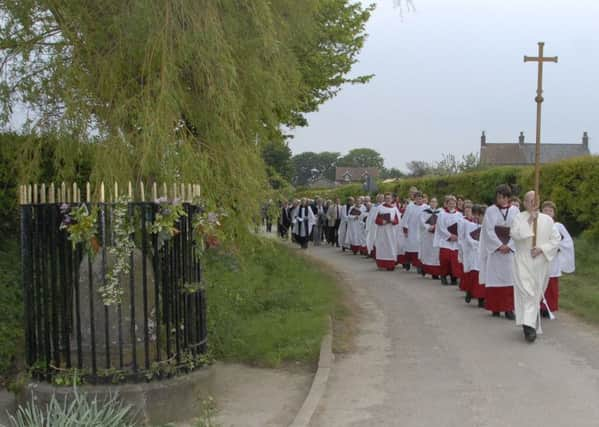Your Day Out: Harpham village '“ full of history and traditions


Had it not been for our ‘ramblings’, we may never have discovered its ancient church; wells with associated legends and traditions; crystal clear waters of Kelk Beck, and the St Quintin Arms. The latter is named after a dynastic family whose details can be traced in the nearby church.
The St Quintins held land in Holderness seven centuries or more ago. Harpham itself passed from father to son without a break from the time of Edward II. Their house has gone, but the church where they rest in peace still stands.
Advertisement
Hide AdAdvertisement
Hide AdThe church has a 15th century tower, a 17th century brick porch, and a 14th century nave and chancel. The whole structure was restored between 1908-1914 by Temple Moore.
Beneath the beautiful arch, between the chancel and chapel, we found an alabaster tomb. William St Quintin died in 1349 and lies beneath the tomb which is adorned with quatrefoils enclosing shields and a crucifixion. On top are engraved portraits of William St Quintin and his wife. You’ll see he is a knight in armour with a sword and dagger. She is in a flowing robe and draped headdress.
The monument in the chancel to Charlotte St Quintin (1762), is signed by the famous sculptor Joseph Wilton, RA. It’s on the north wall, made of white marble, and depicts the figure of grief.
Harpham is well known for Saint John of Beverley, whose body lies in Beverley Minster. He is said to have been born here in 640, amongst the green fields, and Kelk Beck. Our interest was aroused, and led to our returning to Harpham at a later date to partake in a local tradition that has been celebrated on May 2 since 1929. Our visit on that occasion must have been one of the coldest on record.
Advertisement
Hide AdAdvertisement
Hide AdFading daffodils tossed in a biting north-easterly gale. Their tarnished golden heads gilding lanes and embankments as we approached Harpham. The sleepy little village we recalled was transformed into bustling activity, as folk flocked towards the church of St John of Beverley. All were there to partake in what has become a patronal festival for St John, whose body lies in Beverley Minster.
Within the church was an air of excitement and expectancy. A warmth and friendliness radiated from the local villagers. Seated with the assembling congregation in old oak pews made during the 18th century, we pondered its origins. The 62ft tower, which we admired upon arrival, we were told was Early English in style, with a fine view over the countryside from the top.
At 7.15pm, the congregation was welcomed. The crucifer and choir of Beverley Minster led a grand procession to St John’s Well at the east end of Harpham village. In true tradition, a little boy placed a bunch of primroses beside the well.
The domed well-house, encircled by iron railings was crowned by primulas, and the railings festooned in ivy and adorned with a cross and garlands of tulips and daffodils to epitomise spring.
Advertisement
Hide AdAdvertisement
Hide AdSt John is said to have struck his staff upon the ground, from where water has never ceased to flow, even in the driest of summers. Dedicated to St John of Beverley (patron saint of the deaf and dumb), the spring waters are said to cure all ills.
Whilst assembled in silence, the dark clouds parted and the sun beamed momentarily upon the scene. A bible passage was read, and the choir sang a beautiful unaccompanied anthem. Returning to the church in the teeth of a gale, a joyful service followed and the vicar inspired his captivated listeners with details of St John’s life.
Leaving the church, we made our moonlit way to the village hall. There, the ladies had kindly provided a wonderful buffet. The choir boys declared it was “the best in East Yorkshire!” What a splendid supper amongst such congenial company – a perfect ending to an uplifting occasion.
When you visit Harpham, don’t forget its other, somewhat neglected well, likewise encircled by railings. It’s called the Drummer’s Well, and lies at the back of the church. Two stories centre around this haunted well. The first relates that one of Harpham’s former lords (the St Quintins owned it for centuries) killed a drummer boy and threw him into the well, in the depths of which he still plays upon his drum. Another tradition says that he fell in while soldiers were practising archery. He can be heard beating his drum whenever a St Quintin is about to die. The “rat-a-tat-tat” sounds from the drum in the depths of the well.
Wander around this pleasant village and ponder its ancient history and traditions. Then, before you leave, do call at the St Quintin Arms to complete your day.